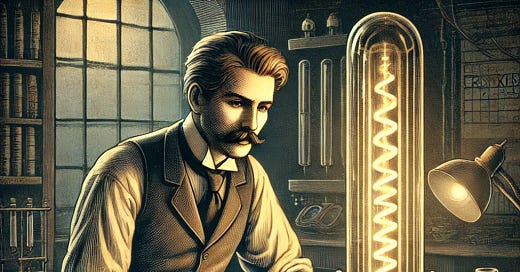If your mind is anything like mine, the theme song for a famous cartoon started playing in your head when you read the title, The Thomsons.
This is not a piece about the famously dysfunctional but loving animated family, but instead about a different notable family.
Just before the 20th century arrived, JJ Thomson was working hard on a cutting-edge physics problem. Crookes tubes were cylinders made of glass filled with a low-pressure gas like hydrogen or neon, or even air that had been depressurized. Electrodes were placed at either end of the tube, and then a high voltage was passed from one end to the other.
This caused a mysterious ray to form inside the tube—a straight glowing line like a light saber. Pretty cool, right?
Scientists noticed that the rays could cast a shadow, and if you placed a small wheel in the way of the beam, the wheel would turn. These two observations seemed to imply that whatever made up the rays had mass.
The mystery deepened when it was observed that these rays could be manipulated and bent by strong magnets.
Here’s where our first hero, JJ, steps into the picture. Working in the late 1890s, Thomson saw first-hand the effects of the magnet on the ray. He knew that manipulating particles with a magnet was consistent with the idea of something that was negatively charged.
Meanwhile, Maxwell’s work had recently unified electricity and magnetism, so they were seen as different manifestations of the same force. Thomson embraced this idea fully, and he wanted to see if improving the vacuum would show what previous experiments had failed to show—that an electric field could also manipulate the mystery rays.
Sure enough, Thomson’s experiment worked, and he bent the rays with an electrical field. Now, he could measure exactly how much they bent, based on how much current was applied. This gave Thomson a charge-to-mass ratio, which he then carefully used to calculate how small a particle must be to make up this ray.
It turned out that the mass had to be insanely tiny—far tinier than even the smallest atoms, shocking the scientific community when it finally accepted Thomson’s results and conclusions. There was something much smaller than an atom, indeed, and it was going to be called the electron.
JJ Thomson’s work had cemented him in the annals of physics and history forever. He eventually won the 1906 Nobel prize in physics for proving once and for all that electrons were particles, not waves.
It must have broken his heart, then, when his son won the Nobel prize for proving that no, actually, electrons really are waves. Sorry, dad.
While JJ was a tinkerer, GP was a thinker. His education at Cambridge, surrounded by some of the greatest minds in physics and mathematics in the world—including his father—prepared his analytical mind for theoretical thinking.
GP served in World War I as an officer in the British Royal Engineers, and this gave young Thomson a first-hand look at cutting edge applied physics. He had that rare ability to combine both a pragmatic, hands-on approach with a deep theoretical framework.
GP’s experiment involved shooting electrons at gold foil. The idea was to try to determine if electrons could, in fact, behave like waves under certain situations. If they were like bullets, you could shoot them at those gold atoms, and they should bounce off in one particular direction. If they were waves, they would create a diffraction pattern, just like water waves.
The results were clear: the electrons scattered like waves, helping to make wave-particle duality central to modern physics.







The Simpsons did go incognito in one episode as "The Thompsons" (with a P, so no relation to J.J.) and the title card/theme music were modified accordingly, as you suggested...
There's no word on whether JJ, upon seeing GP's findings, exclaimed "D'oh!"
But we must assume he 100% did that.